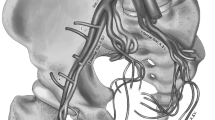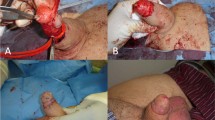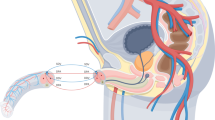Key Points
-
Organ-preserving surgery is a reasonable approach in managing early-stage penile cancer when oncologically feasible to retain quality of life and maximize sexual function
-
Conservative treatment decisions for penile cancer are critically based on clinical and pathological information that defines prognostic disease risk
-
Conservative strategies for penile cancer treatment are supported by analyses indicating that long-term survival is maintained despite the possibility of localized disease recurrence
-
The surgical plan for conservative penile cancer treatment combines extirpative and reconstructive procedures with the latter aspect dictated by the features of the surgical defect
-
Patient education and adherence to surveillance protocols are recommended when implementing conservative penile cancer treatment strategies
Abstract
A major paradigm shift has occurred in the clinical management of penile cancer: the adoption of alternative, less-invasive surgical strategies to address the primary tumour. Such penile-preserving approaches aim to retain aspects of penile function and improve quality of life outcomes by reducing penile alterations and sexual dysfunction incurred by historical surgical approaches without compromising oncological control. Novel options include wide local excision, glansectomy, and glans resurfacing, and these strategies are now included in the spectrum of interventions available to treat penile cancer. Surgical reconstructive techniques have also advanced to include primary closure, closure using skin flaps and grafts, penile lengthening and/or enhancement, and neophalloplasty. All of these options can be readily applied in the risk-informed patient after establishing disease-risk variables and instituting protocols for close surveillance and prompt action for possible disease recurrence.
This is a preview of subscription content, access via your institution
Access options
Subscribe to this journal
Receive 12 print issues and online access
$209.00 per year
only $17.42 per issue
Buy this article
- Purchase on Springer Link
- Instant access to full article PDF
Prices may be subject to local taxes which are calculated during checkout







Similar content being viewed by others
References
Barnholtz-Sloan, J. S., Maldonado, J. L., Pow-sang, J. & Giuliano, A. R. Incidence trends in primary malignant penile cancer. Urol. Oncol. 25, 361–367 (2007).
Hakenberg, O. W. et al. EAU guidelines on penile cancer: 2014 update. Eur. Urol. 67, 142–150 (2015).
Ravi, R. Correlation between the extent of nodal involvement and survival following groin dissection for carcinoma of the penis. Br. J. Urol. 72, 817–819 (1993).
McDougal, W. S. Carcinoma of the penis: improved survival by early regional lymphadenectomy based on the histological grade and depth of invasion of the primary lesion. J. Urol. 154, 1364–1366 (1995).
Theodorescu, D., Russo, P., Zhang, Z. F., Morash, C. & Fair, W. R. Outcomes of initial surveillance of invasive squamous cell carcinoma of the penis and negative nodes. J. Urol. 155, 1626–1631 (1996).
Pizzocaro, G., Piva, L., Bandieramonte, G. & Tana, S. Up-to-date management of carcinoma of the penis. Eur. Urol. 32, 5–15 (1997).
Slaton, J. W. et al. Tumor stage, vascular invasion and the percentage of poorly differentiated cancer: independent prognosticators for inguinal lymph node metastasis in penile squamous cancer. J. Urol. 165, 1138–1142 (2001).
Srinivas, V., Morse, M. J., Herr, H. W., Sogani, P. C. & Whitmore, W. F. Jr. Penile cancer: relation of extent of nodal metastasis to survival. J. Urol. 137, 880–882 (1987).
Horenblas, S. & van Tinteren, H. Squamous cell carcinoma of the penis. IV. Prognostic factors of survival: analysis of tumor, nodes and metastasis classification system. J. Urol. 151, 1239–1243 (1994).
Lont, A. P. et al. Pelvic lymph node dissection for penile carcinoma: extent of inguinal lymph node involvement as an indicator for pelvic lymph node involvement and survival. J. Urol. 177, 947–952; discussion 952 (2007).
Leijte, J. A., Kirrander, P., Antonini, N., Windah, l. T. & Horenblas, S. Recurrence patterns of squamous cell carcinoma of the penis: recommendations for follow-up based on a two-centre analysis of 700 patients. Eur. Urol. 54, 161–168 (2008).
Fleming, I. D. et al. in AJCC Cancer Staging Manual 5th edn (ed. Goolsby, J.) 215–217 (Lippincott-Raven Publishers, 1997).
Ficarra, V. et al. Lymphatic and vascular embolizations are independent predictive variables of inguinal lymph node involvement in patients with squamous cell carcinoma of the penis: Gruppo Uro-Oncologico del Nord Est (Northeast Uro-Oncological Group) penile cancer data base data. Cancer 103, 2507–2516 (2005).
Graafland, N. M. et al. Prognostic factors for occult inguinal lymph node involvement in penile carcinoma and assessment of the high-risk EAU subgroup: a two-institution analysis of 342 clinically node-negative patients. Eur. Urol. 58, 742–747 (2010).
Alkatout, I. et al. Squamous cell carcinoma of the penis: predicting nodal metastases by histologic grade, pattern of invasion and clinical examination. Urol. Oncol. 29, 774–781 (2011).
Hakenberg, O. W. et al. EAU Guidelines on Penile cancer: 2014 update. Eur. Urol. 67, 142–150 (2015).
Crook, J., Ma, C. & Grimard, L. Radiation therapy in the management of the primary penile tumor: an update. World J. Urol. 27, 189–196 (2009).
Crook, J., Jezioranski, J. & Cygler, J. E. Penile brachytherapy: technical aspects and postimplant issues. Brachytherapy 9, 151–158 (2010).
de Crevoisier, R. et al. Long-term results of brachytherapy for carcinoma of the penis confined to the glans (N− or NX). Int. J. Radiat. Oncol. Biol. Phys. 74, 1150–1156 (2009).
Azrif, M. et al. External-beam radiotherapy in T1-2 N0 penile carcinoma. Clin. Oncol. R. Coll. Radiol. 18, 320–325 (2006).
Kelley, C. D., Arthur, K., Rogoff, E. & Grabstald, H. Radiation therapy of penile cancer. Urology 4, 571–573 (1974).
Duncan, W. & Jackson, S. M. The treatment of early cancer of the penis with megavoltage x-rays. Clin. Radiol. 23, 246–248 (1972).
Alnajjar, H. M. et al. Treatment of carcinoma in situ of the glans penis with topical chemotherapy agents. Eur. Urol. 62, 923–928 (2012).
Frimberger, D. et al. Penile carcinoma. Is Nd:YAG laser therapy radical enough? J. Urol. 168, 2418–2421 discussion 2421 (2002).
Shabbir, M. et al. Glans resurfacing for the treatment of carcinoma in situ of the penis: surgical technique and outcomes. Eur. Urol. 59, 142–147 (2011).
Mohs, F. E., Snow, S. N., Messing, E. M. & Kuglitsch, M. E. Microscopically controlled surgery in the treatment of carcinoma of the penis. J. Urol. 133, 961–966 (1985).
Shindel, A. W. et al. Mohs micrographic surgery for penile cancer: management and long-term followup. J. Urol. 178, 1980–1985 (2007).
Clark, P. E. et al. Penile cancer: clinical practice guidelines in oncology. J. Natl Compr. Canc. Netw. 11, 594–615 (2013).
McDougal, W. S., Kirchner, F. K. Jr, Edwards, R. H. & Killion, L. T. Treatment of carcinoma of the penis: the case for primary lymphadenectomy. J. Urol. 136, 38–41 (1986).
Horenblas, S. et al. Squamous cell carcinoma of the penis. II. Treatment of the primary tumor. J. Urol. 147, 1533–1538 (1992).
Ornellas, A. A. et al. Surgical treatment of invasive squamous cell carcinoma of the penis: Brazilian National Cancer Institute long-term experience. J. Surg. Oncol. 97, 487–495 (2008).
Philippou, P. et al. Conservative surgery for squamous cell carcinoma of the penis: resection margins and long-term oncological control. J. Uro. 188, 803–808 (2012).
Hadway, P., Corbishley, C. M. & Watkin, N. A. Total glans resurfacing for premalignant lesions of the penis: initial outcome data. BJU Int. 98, 532–536 (2006).
Li, J. et al. Organ-sparing surgery for penile cancer: complications and outcomes. Urology 78, 1121–1124 (2011).
Frimberger, D. et al. Autofluorescence and 5-aminolevulinic acid induced fluorescence diagnosis of penile carcinoma — new techniques to monitor Nd:YAG laser therapy. Urol. Res. 30, 295–300 (2002).
Meijer, R. P., Boon, T. A., van Venrooij, G. E. & Wijburg, C. J. Long-term follow-up after laser therapy for penile carcinoma. Urology 69, 759–762 (2007).
Agrawal, A., Pai, D., Ananthakrishnan, N., Smile, S. R. & Ratnakar, C. The histological extent of the local spread of carcinoma of the penis and its therapeutic implications. BJU Int. 85, 299–301 (2000).
Minhas, S. et al. What surgical resection margins are required to achieve oncological control in men with primary penile cancer? BJU Int. 96, 1040–1043 (2005).
Gotsadze, D., Matveev, B., Zak, B. & Mamaladze, V. Is conservative organ-sparing treatment of penile carcinoma justified? Eur. Urol. 38, 306–312 (2000).
Hernandez, B. Y. et al. Burden of invasive squamous cell carcinoma of the penis in the United States, 1998–2003. Cancer 113, 2883–2891 (2008).
Garaffa, G., Raheem, A. A., Christopher, N. A. & Ralph, D. J. Total phallic reconstruction after penile amputation for carcinoma. BJU Int. 104, 852–856 (2009).
Segal, R. L. et al. Inflatable penile prosthesis technique and outcomes after radial forearm free flap neophalloplasty. Int. J. Impot. Res. 27, 49–53 (2014).
Das, S. Penile amputations for the management of primary carcinoma of the penis. Urol. Clin. North Am. 19, 277–282 (1992).
Loughlin, K. R. The rosebud technique for creation of a neomeatus after partial or total penectomy. Br. J. Urol. 76, 123–124 (1995).
Hegarty, P. K. et al. Penile preserving surgery and surgical strategies to maximize penile form and function in penile cancer: recommendations from the United Kingdom experience. World J. Urol. 27, 179–187 (2009).
Parkash, S., Ananthakrishnan, N. & Roy, P. Refashioning of phallus stumps and phalloplasty in the treatment of carcinoma of the penis. Br. J. Surg. 73, 902–905 (1986).
Pietrzak, P., Corbishley, C. & Watkin, N. Organ-sparing surgery for invasive penile cancer: early follow-up data. BJU Int. 94, 1253–1257 (2004).
Gulino, G., Sasso, F., Falabella, R. & Bassi, P. F. Distal urethral reconstruction of the glans for penile carcinoma: results of a novel technique at 1-year of followup. J. Urol. 178, 941–944 (2007).
Smith, Y. et al. Penile-preserving surgery for male distal urethral carcinoma. BJU Int. 100, 82–87 (2007).
Austoni, E. et al. New trends in the surgical treatment of penile carcinoma. Arch. Ital. Urol. Androl. 68, 163–168 (1996).
Smith, Y. et al. Reconstructive surgery for invasive squamous carcinoma of the glans penis. Eur. Urol. 52, 1179–1185 (2007).
Bracka, A. Glans resection and plastic repair. BJU Int. 105, 136–144 (2010).
Morelli, G. et al. Glansectomy with split-thickness skin graft for the treatment of penile carcinoma. Int. J. Impot Res. 21, 311–314 (2009).
Palminteri, E., Berdondini, E., Lazzeri, M., Mirri, F. & Barbagli, G. Resurfacing and reconstruction of the glans penis. Eur. Urol. 52, 893–898 (2007).
Ubrig, B., Waldner, M., Fallahi, M. & Roth, S. Preputial flap for primary closure after excision of tumors on the glans penis. Urology 58, 274–276 (2001).
Wallen, J. J. et al. Optimizing penile length in patients undergoing partial penectomy for penile cancer: novel application of the ventral phalloplasty oncoplastic technique. Int. Braz. J. Urol. 40, 708–709 (2014).
Hage, J. J. Simple, safe, and satisfactory secondary penile enhancement after near-total oncologic amputation. Ann. Plast. Surg. 62, 685–689 (2009).
Bluebond-Langner, R. & Redett, R. J. Phalloplasty in complete aphallia and ambiguous genitalia. Semin. Plast. Surg. 25, 196–205 (2011).
Feldman, A. S. & McDougal, W. S. Long-term outcome of excisional organ sparing surgery for carcinoma of the penis. J. Urol. 186, 1303–1307 (2011).
Romero, F. R. Sexual function after partial penectomy for penile cancer. Urology 66, 1292–1295 (2005).
Maddineni, S. B. et al. Identifying the needs of penile cancer sufferers: a systematic review of the quality of life, psychosexual and psychosocial literature in penile cancer. BMC Urol. 9, 8 (2009).
Keiffer, J. M. et al. Quality of life for patients treated for penile cancer. J. Urol. 192, 1105–1110 (2014).
Gulino, G. et al. Sexual outcomes after organ potency-sparing surgery and glans reconstruction in patients with penile carcinoma. Indian J. Urol. 29, 119–123 (2013).
Author information
Authors and Affiliations
Corresponding author
Ethics declarations
Competing interests
The author declares no competing financial interests.
Rights and permissions
About this article
Cite this article
Burnett, A. Penile preserving and reconstructive surgery in the management of penile cancer. Nat Rev Urol 13, 249–257 (2016). https://doi.org/10.1038/nrurol.2016.54
Published:
Issue Date:
DOI: https://doi.org/10.1038/nrurol.2016.54
This article is cited by
-
At The Forefront of Penile Surgical Reconstruction: A Bibliometric Study of the 100 Most-Cited Articles
Aesthetic Plastic Surgery (2022)
-
Penile cancer
Nature Reviews Disease Primers (2021)
-
Penile Cancer: Managing Sexual Dysfunction and Improving Quality of Life After Therapy
Current Urology Reports (2021)
-
Multidimensional integrative analysis uncovers driver candidates and biomarkers in penile carcinoma
Scientific Reports (2017)
-
Current Management Strategy for Penile Cancer and Future Directions
Current Oncology Reports (2017)



